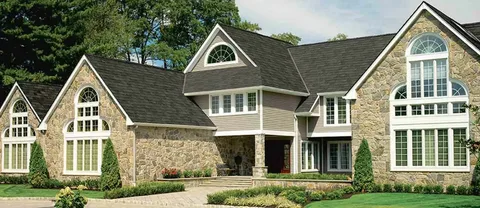Solar roofing in Calgary means roof systems that generate clean power while shielding your home or building from our snowy but sunny climate. Strong sun hours, hail risk and freeze-thaw cycles define product selection, from integrated solar shingles to rack-mounted panels on metal or flat roofs. For lower bills, better resale and dependability in Alberta winters, local design and code-compliant installs matter. Superior Roofing Ltd. adds Calgary expertise, hail-resistant products and clean, safe wiring to each solar roof.
Calgary’s Solar Advantage
Calgary’s solar advantage. With over 2,300 hours of sunshine a year and more than 300 sunny days, there’s steady and predictable output from rooftop systems throughout most neighbourhoods in the city.
High solar yield in a cold, bright climate
Cold air helps panels run more efficiently, and winter snow can reflect light to the modules, increasing output on clear days. South- and west-facing roofs in Tuscany, Lake Bonavista, or McKenzie Towne can easily support 5 to 10 kW arrays, which meet or exceed an average home’s daily consumption. Low-maintenance equipment and reinforced racking withstand Chinook winds and freeze-thaw cycles, as advanced inverters maintain consistent output throughout the seasons.
Long-term savings and bill control
With Calgary’s strong sun hours, systems produce a significant portion of your electricity and reduce demand from the grid. That cuts monthly bills and can hedge against rate volatility in Alberta’s market. Across its 25-plus years of service life, avoided electricity costs accumulate, while net billing credits for excess power provide cash flow benefits. Many owners also benefit from increased resale value. Solar increases property value an average of three to four percent, depending on the system’s size and age, among other variables.
Rebates and financing that ease upfront costs
Alberta homeowners can even stack federal incentives with local programs when available, reducing the installed price. These could include items such as point-of-sale rebates, tax incentives, and low-interest financing. These supports reduce payback and make upgrades, such as higher-efficiency modules or black-on-black aesthetics, more accessible to Calgary homes and small commercial roofs.
Cleaner power and energy independence
Each kilowatt-hour you generate on your rooftop replaces grid electricity, reducing your carbon footprint. Over time, this means fewer emissions with no impact on your daily lifestyle at home. Producing your own power means you’re in charge. You become less dependent on the grid, have more consistent rates, and gain greater protection from peak demand or price surges.
Solar Built for Chinooks
Calgary’s wild swings—from −25°C cold snaps to warm Chinooks—require solar roofing that stays put. Today’s modules utilize tempered glass, rugged frames, and sealed backsheets rated for hail, high UV, and rapid thermal cycling. Systems we specify combine CSA/UL-listed panels with racking tested for uplift loads prevalent along the Bow Valley wind corridor, along with stainless fasteners and flashing that remain watertight through freeze-thaw cycles.
Durable by design for rapid temperature swings and wind
High-quality panels are thoroughly thermal-cycle tested, exceeding local standards, and maintain their output even after thousands of hot-cold cycles. Wind-resistant racking with continuous rails and locked mid-clamps distributes the load and reduces point stress, a requirement for ridge and escarpment locations in the southwest. Before installation, we inspect the roof structure for additional superimposed dead loads and, if necessary, install blocking or upgrade substrates to minimize deflection.
Snow-shedding and angles that work with Chinooks
A 30- to 40-degree angle of tilt optimizes for winter sun and shedding. Black-framed, glass-glass choices retain heat, and snow slides off with Chinooks. Clear edge pathways, smooth module glass, and unobstructed eaves accelerate melt flow, so strings rise sooner and yield more on brief winter days.
Minimal upkeep in freeze-thaw cycles
- Visual roof and array check each spring and fall
- Racking torque check annually
- Module wash as needed with soft water; no abrasives
- Monitor portal alerts for string faults or shade issues
- Defined safe access routes. Don’t have to chip ice on modules.
- Shovel only if necessary for safety. Use non-metal shovels.
Calgary performance vs. other Canadian cities
Calgary’s cold, sunny winters actually increase panel efficiency and yield, sometimes comparable to or even exceeding those of sites with milder temperatures and fewer clear days. We experience less salt corrosion and more stable output than in coastal cities. While higher wind design is critical compared to central prairie sites, it is doable with the right racking and anchors.
Proof in practice: Chinook Centre rooftop pilot
About: Solar Built for Chinooks Chinook Centre’s 1,900-panel rooftop array shows local viability. It aims to achieve nearly 900,000 kWh per year, which is approximately 10% of the mall’s total consumption, thereby offsetting approximately 650 tonnes of CO₂ each year. The large roof and high demand made it a suitable fit; however, additional SDL was addressed in the design. From hardware to software to communications, it was adapted for two-way power flow on a secondary network, sending excess back to the grid, which is an innovative first for a segment of the grid that normally flows only one way. The system went live in May, with full commissioning planned for early 2022, demonstrating that solar can integrate with Calgary’s Chinooks, snow, and utility demands.
Your Residential Solar Installation
Solar on a Calgary home reduces power bills, adds value, and lowers carbon emissions. With over 2,300 hours of sun a year, systems perform well here and continue to generate in the winter, although snow can impede production. The majority of systems recoup their cost in 8 to 12 years and have a lifespan of 25 to 30 years, providing you with decades of inexpensive electricity.
What to expect, step by step
- Site assessment: Roof condition, pitch, shade check, service panel review.
- Design: module count, layout, inverter type, conduit routes.
- Quote and incentives: final price, return on investment, grant or rebate stack (for example, Canada Greener Homes up to 10%).
- Permits and electrical approvals: city and utility submissions.
- Procurement: panels, racking, an inverter, and monitoring.
- Roof prep: repairs or shingle upgrades if needed.
- Installation: racking, flashing, modules, wiring, and labelling.
- Inspection: Approval of municipal and utility meters.
- Commissioning: system activation and monitoring setup.
- Handover: warranties, owner training, maintenance plan.
What affects timelines
- Roof condition and needed repairs.
- System size and complexity (microinverters vs. string).
- Electrical service upgrades (e.g., 100 A to 200 A).
- Permit and utility queue times.
- Weather windows around snow, wind, or deep freeze.
How to prep your home and roof
Unobstructed attic access and service panel workspace. Cut back the shading trees. Verify Wi-Fi connectivity in proximity to the inverter for monitoring purposes. Plan minor roof repairs before installation. Newer asphalt shingles or metal support install best. Design snow guards for steep south-facing slopes. Keep the driveway clear for the crew and materials.
Typical costs and timelines in Calgary
- Small home (3–5 kW): $9,000 to $15,000 CAD, 1 to 2 days installation, payback 10 to 12 years.
- Medium home (6 to 8 kW): $16,000 to $24,000 CAD. 2 to 3 days. Payback period is 9 to 11 years.
- Large home (9–12 kW): $25,000–$36,000 CAD, 3–4 days, payback 8–10 years. Stack rebates can slash totals by up to 10%. Systems add approximately 4% to home value on resale.
Ongoing care remains simple: a quick annual check, tightening hardware as needed, and rinsing modules as necessary to maintain peak output.
Choosing Your Solar Roof
Calgary’s sun, snow, and wind demand a solar roof that optimizes output, aesthetics, and long-term value. Begin with the roof’s condition, orientation, pitch, and structural capacity. Then align product type, warranty, and service support to your objectives.
Integrated Tiles vs. Traditional Panels
All this integrated solar roof tile camouflage not only makes solar aesthetically pleasing but can also enhance curb appeal on high-visibility homes in Lake Bonavista, Altadore, or Mount Royal. They cost more per watt and often run at lower efficiency, so you might require a greater surface area to reach the same kilowatt-hour. Conventional framed panels provide more output per square metre, superior cooling, and easier maintenance. On south-facing roofs with a 30 to 45-degree pitch, panels routinely outperform tiles in Calgary’s climate. In winter, steeper panel arrays closer to 60 degrees remove snow faster and increase yield during short days.
Material and Roof Compatibility
The majority of Calgary roofs are made of asphalt shingles, concrete tiles, metal (standing seam), or low-slope membranes. Panels pair well with architectural asphalt and standing-seam metal, as non-penetrating clamps are used for support. Concrete tile requires specialized mounts and careful flashing. Low-slope roofs can accommodate ballasted arrays if the structure is adequate, but snow drift and wind need to be engineered. Your roof needs to be in good shape and rated for additional dead load, as panels and racking can contribute up to three pounds per square foot. Replace roofs before installing solar panels, as it is expensive to remove arrays for re-roofing later.
Lifespan and Warranty Alignment
Pick your solar roof wisely. Good panels will last 25 to 30 years with performance guarantees, typically achieving 80 to 92 percent efficiency by year 25. Inverters vary in lifespan: string inverters typically last 10 to 15 years, while microinverters and optimizers often last 20 to 25 years. Seek product, performance, and workmanship protection from trusted brands with Canadian support, plus installer labour warranties and transparent snow and wind load ratings tailored to Calgary.
Priority Checklist: What Matters Most
- Aesthetics: street-facing slope, tile versus panel profile, colour match.
- Budget: Total installed cost in CAD, rebates, and payback window.
- Energy Goals: Target annual kWh usage, EV charging needs, and future loads, including heat pump usage.
- Roof Health: Age, membrane or granule wear, deck integrity, and next replacement timing.
- Orientation and Pitch: A south-facing orientation is best. Thirty to forty-five degrees is optimal. Sixty degrees aids in winter.
- Sun Access: shade mapping for trees, chimneys, neighbouring buildings.
- Structure: load capacity for ~3 lb/sq ft plus snow/wind.
- Maintenance: annual inspections for mounts, wiring, and module condition.
Navigating Local Regulations
Navigating Alberta’s rules and the City’s permits for solar roofing in Calgary. Calgary has a defined process, and the AHJ can include site and scope-based steps.
Summarize Calgary’s permitting process and required documentation for residential solar projects.
Most homes need up to three permits: electrical (mandatory province-wide), building (when roof structure is altered or loading changes), and development (triggered by location, heritage, or height/placement issues). Some sites may proceed with just the electrical permit if the AHJ verifies that no other triggers are present. Submissions typically include a completed application, one-line electrical diagrams stamped by a licensed professional, a roof layout and site plan with panel count and setbacks, module and inverter specification sheets, and a structural letter. Calgary still frequently requests structural engineering services where dead or live loads shift, and many Alberta authorities, such as Edmonton, require this as an entry point. Utilities require a micro-generation interconnection form for net metering.
Clarify city bylaws regarding panel placement, height restrictions, and neighbourhood guidelines.
Rooftop arrays must remain within the roof edges and comply with setback regulations to prevent panels from overhanging the eaves. They cannot be taller than the maximum roof height in the land use district, and tilted racking cannot push arrays past the permissible profile. Corner lots and heritage areas will have more stringent street-facing limits. Rowhouse and condo sites typically require approval from the condo board. Ground arrays require different setbacks and may necessitate the issuance of development permits. To prevent glare onto streets and neighbours, AHC can ask for mitigation.
Provide a step-by-step list of actions to ensure your solar project meets all local regulations.
- Verify zoning and determine if a development permit is required.
- Hire a certified Alberta solar contractor with local AHJ experience.
- Order structural assessment for roof capacity and snow load.
- Get your stamped one-line site plan and equipment specs ready.
- File for the electrical permit and any required building or development permits.
- Obtain utility interconnection approval for micro-generation.
- Schedule inspections; keep as-builts and warranties on file.
- And certainly not install with non-certified crews. Warranties could be void.
The Grid-Tied Reality
Grid-tied solar systems suit Calgary and its surrounding towns, including Okotoks, Chestermere, and Airdrie, where dependable utility service and open skies yield robust returns. It connects your rooftop array to the grid, allowing you to consume what you produce first, then draw from or contribute to the grid as needed.
How credits work when you export power
In sunny hours, panels usually produce more than you need. The surplus goes out to the grid and is monitored by a two-way meter. Under Alberta’s Micro-Generation Regulation, those exports accrue energy credits on your bill. Credits compensate for the power you consume at night or on overcast days, reducing expenses automatically.
Why net metering boosts ROI
Net metering converts daytime excess into bill credits, accelerating payback by reducing the most expensive kilowatt-hour on your bill. Because grid-tied systems bypass large battery banks, upfront costs remain lower than those of off-grid systems, so capital really gets to work. In Calgary, that translates to consistent year-round value with robust summer production compensating for winter consumption.
Outages and when batteries make sense
A typical grid-tied setup ceases operation during a grid outage to safeguard line workers. It won’t power lights unless you supplement with a battery or a hybrid inverter with backup circuits. A small battery bank cannot cover all your key loads—such as the furnace fan, fridge, and lights—for a few hours in an outage, while larger packs can take care of longer events. Batteries bring cost and complexity, but they drive resilience.
What changes on your monthly bill
Anticipate a reduced energy bill due to export credits and self-consumption. There are fixed delivery and admin fees. In high-sun months, credits may roll over to offset future use. In winter, you will pull more from the grid. With monitoring apps that display daily import and export, you can shift use, such as laundry or EV charging, to daytime for more savings.
Timeline and performance you can count on
From consult to PTO, the majority of installs take 4 to 8 weeks. Once active, grid-tied arrays provide consistent, cost-effective production with low maintenance and long-lasting components designed for Calgary’s freeze-thaw cycles and hail hazard.
Conclusion
Solar roofing Calgary: cold, sun, chinooks—not an issue with the right setup. It’s strong panels, clean wiring, and a clever tie-in to the grid. Clean permits, equitable interconnect, and actual savings in the long run. The roof is sharp, bills drop, and home value goes up. Easy as pie.
Need a no-frills quote and tidy install? Call Superior Roofing Calgary or drop us a line to schedule a site check and shade study. Already sizzlin’ with anticipation? Let’s design your solar roof today.



 :
:









